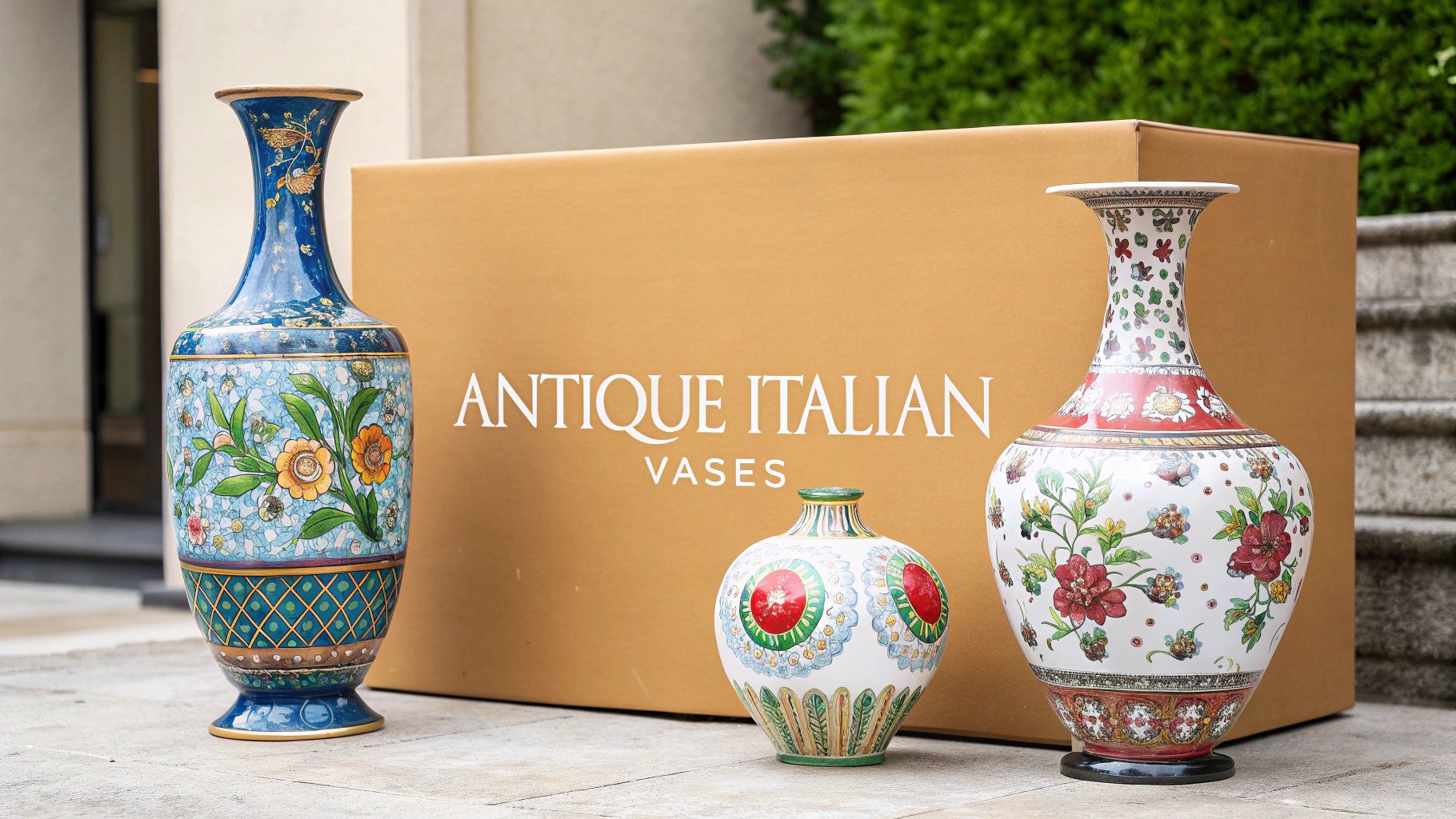Antique Italian vases are so much more than just pretty objects on a shelf. They're real, tangible pieces of history, each one capturing centuries of evolving art and fierce regional pride. You have the vibrant Majolica earthenware, the exquisite Murano glass, and the ornate Capodimonte porcelain—each telling its own unique story of Italian skill.
The Enduring Appeal of Italian Antique Vases
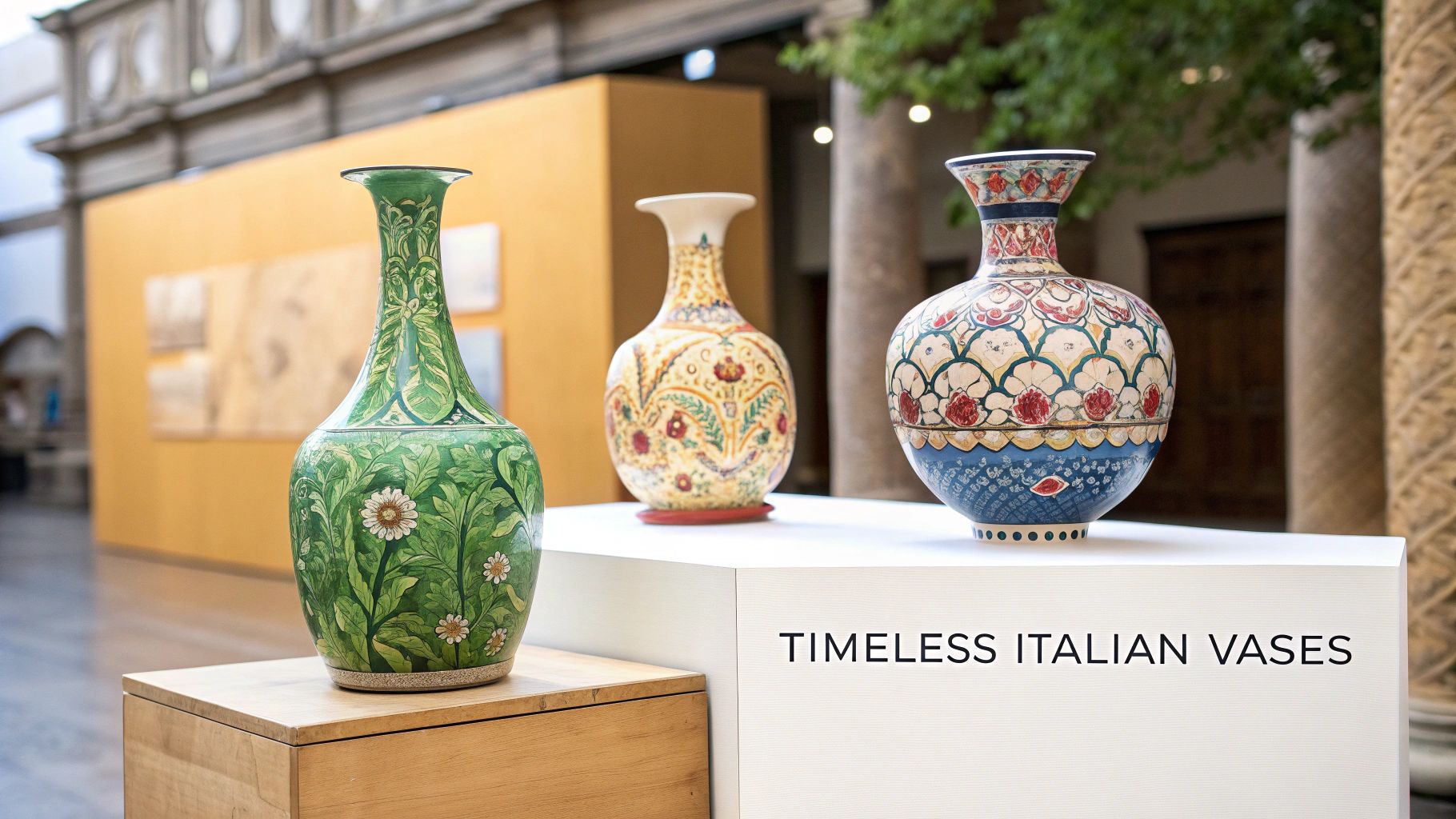
Diving into the world of antique Italian vases is like cracking open a history book written in clay, glass, and glaze. Every single piece is a testament to the culture, the technology, and the artistic passions of the era it came from. These aren't just containers; they are artifacts that carry the legacy of Italian artisans who spent generations perfecting their craft.
The urge to own these beautiful objects isn’t new. Long before the 18th-century "Vasemania" craze, sparked by wealthy Europeans on the Grand Tour, collectors in Italy were already building their own impressive stashes. Back in the 16th and 17th centuries, influential people in Venice and Padua saw the artistic and historical worth of ancient Greek and South Italian painted vases, treating them as true works of art. You can learn more about this early history of vase collecting. This long-standing appreciation really underscores why these items have always been seen as treasures.
Why Collectors Cherish These Pieces
So, what exactly turns a simple vase into a sought-after antique? It’s a mix of incredible artistry, deep history, and the one-of-a-kind story each piece carries. For a collector, getting your hands on an antique Italian vase is about connecting with a rich cultural heritage.
Here’s a breakdown of what makes them so special:
- Unmatched Craftsmanship: The level of detail is just extraordinary. Think of the hand-painted stories on Majolica or the delicate, hand-applied flowers on Capodimonte porcelain.
- Historical Significance: A single vase can reflect the tastes of Renaissance patrons, the breakthroughs of Venetian glassblowers, or the Rococo elegance of Neapolitan courts.
- Regional Diversity: Italy's history as a collection of city-states meant that distinct regional styles flourished. A vase from Deruta looks completely different from one made in Murano, which gives collectors a rich and varied world to explore.
Owning an antique vase from Italy is like having a small, beautiful ambassador from another era. It’s a direct link to the hands that shaped it and the world that inspired its creation.
Consider this guide your roadmap for navigating this fascinating territory. We'll introduce you to the giants of Italian craftsmanship and give you the knowledge you need to appreciate, identify, and confidently invest in these timeless treasures.
Understanding Italy's Rich Artistic Traditions
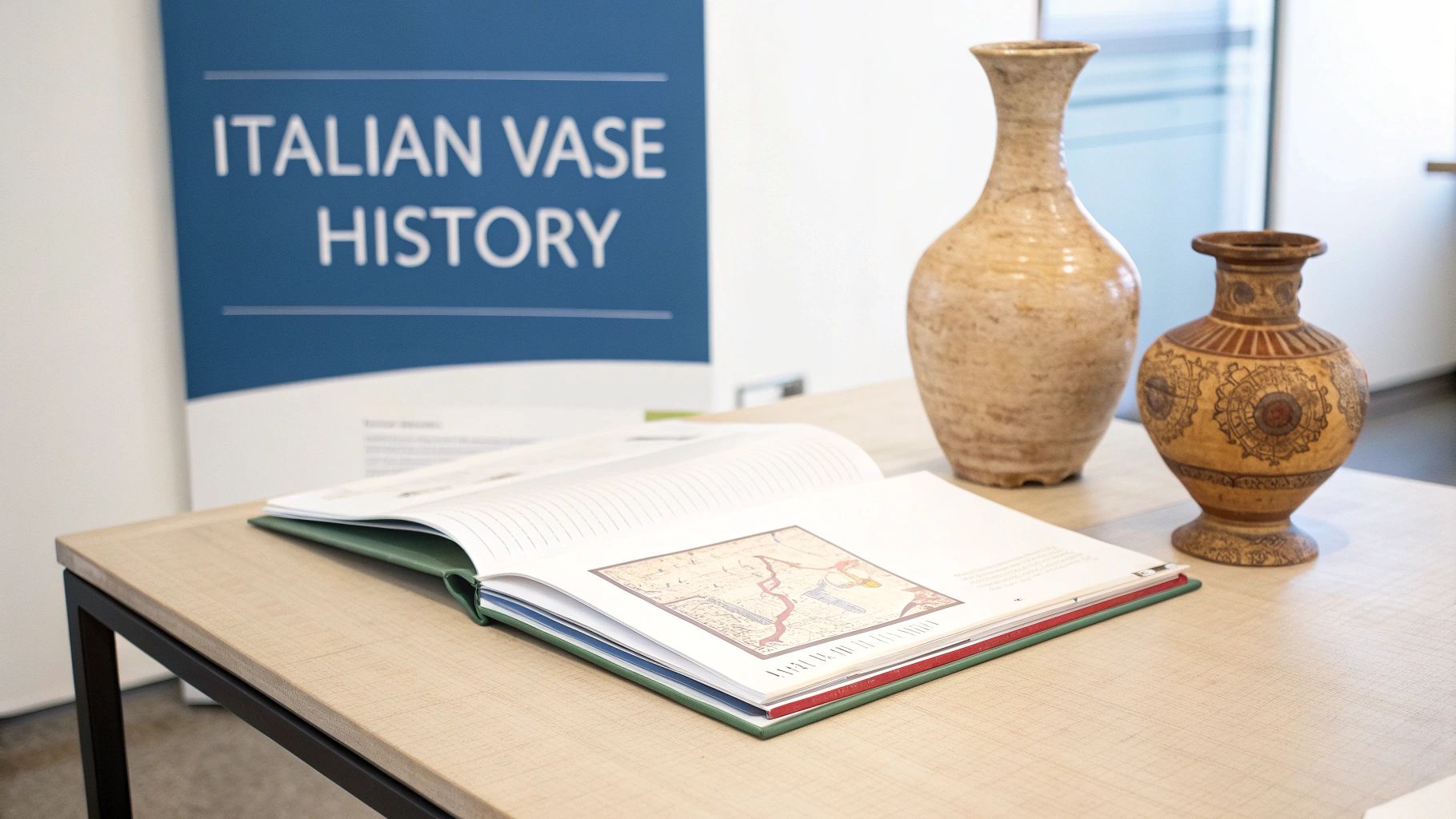 To really get a feel for an antique Italian vase, you have to understand the world it came from. Every piece tells a story of its time, a story shaped by history, new inventions, and the ever-changing tides of artistic taste. This isn't just a history lesson; it's about seeing how culture and passion came together to create these incredible objects.
To really get a feel for an antique Italian vase, you have to understand the world it came from. Every piece tells a story of its time, a story shaped by history, new inventions, and the ever-changing tides of artistic taste. This isn't just a history lesson; it's about seeing how culture and passion came together to create these incredible objects.
The story starts with the earth itself. Long before the dazzling courts of the Renaissance, ancient civilizations across Italy were mastering earthenware. These early traditions laid the foundation for everything that came after, building a deep-rooted culture of ceramic art. As you dig into Italy's artistic heritage, you'll find a stunning variety of materials and shapes, like this distinctive old terracotta vase that feels connected to those ancient beginnings.
The Renaissance and the Rise of Majolica
The real fireworks in Italian ceramics started during the Renaissance. This cultural explosion sparked a new hunger for beauty and luxury, and local potters more than met the challenge with Majolica. You can think of it as earthenware's glamorous, artistic cousin.
Majolica is a special kind of tin-glazed pottery. This technique created a brilliant, white surface that was the perfect canvas for painting. All of a sudden, vases went from being simple household items to story-telling treasures, covered in vibrant scenes from mythology, history, and everyday life. Workshops in cities like Deruta, Faenza, and Urbino became famous, each developing its own signature style that collectors can still recognize today.
The invention of Majolica was a game-changer. It elevated humble pottery to a true art form, essentially allowing artisans to "paint with fire" and capture the vibrant spirit of the Renaissance on a ceramic surface.
The Royal Pursuit of Porcelain
As tastes shifted towards something even more refined, the race was on to unlock the secrets of porcelain. For centuries, China held the exclusive recipe for true hard-paste porcelain, and European royalty was obsessed with cracking the code. In the 18th century, King Charles VII of Naples founded the Royal Factory of Capodimonte to do just that.
His mission was to create porcelain that could go head-to-head with the celebrated Meissen porcelain from Germany. The result was Capodimonte porcelain, a "soft-paste" variety known for its creamy white hue and unbelievable delicacy. These vases were often decorated with classical scenes or, most famously, with incredibly detailed, hand-sculpted flowers and figures that seemed to leap off the surface. It was a style that perfectly captured the lavish, romantic mood of the Rococo period.
Generally, you'll encounter three major artistic traditions:
- Majolica: Tin-glazed earthenware celebrated for its colorful, painted stories.
- Capodimonte: Delicate soft-paste porcelain, famous for its ornate, three-dimensional flowers and figures.
- Murano Glass: World-famous glass known for its brilliant colors and groundbreaking techniques born on the island of Murano.
The Venetian Secret of Murano Glass
Finally, our journey takes us north to the Venetian lagoon and the island of Murano. For hundreds of years, Venice had a stranglehold on high-end glassmaking in Europe. To guard their precious trade secrets, the Venetian government ordered all glassmakers to move to the island of Murano in 1291.
This forced isolation created a hotbed of creativity and competition. Murano's masters developed techniques that are still legendary, producing glass with unmatched color and clarity. From the mesmerizing patterns of millefiori (a thousand flowers) to the milky-white beauty of lattimo glass, Murano vases became the ultimate symbols of Venetian wealth and power. Each of these traditions gives us a unique window into Italy’s artistic soul.
Learning to Spot the Major Italian Styles
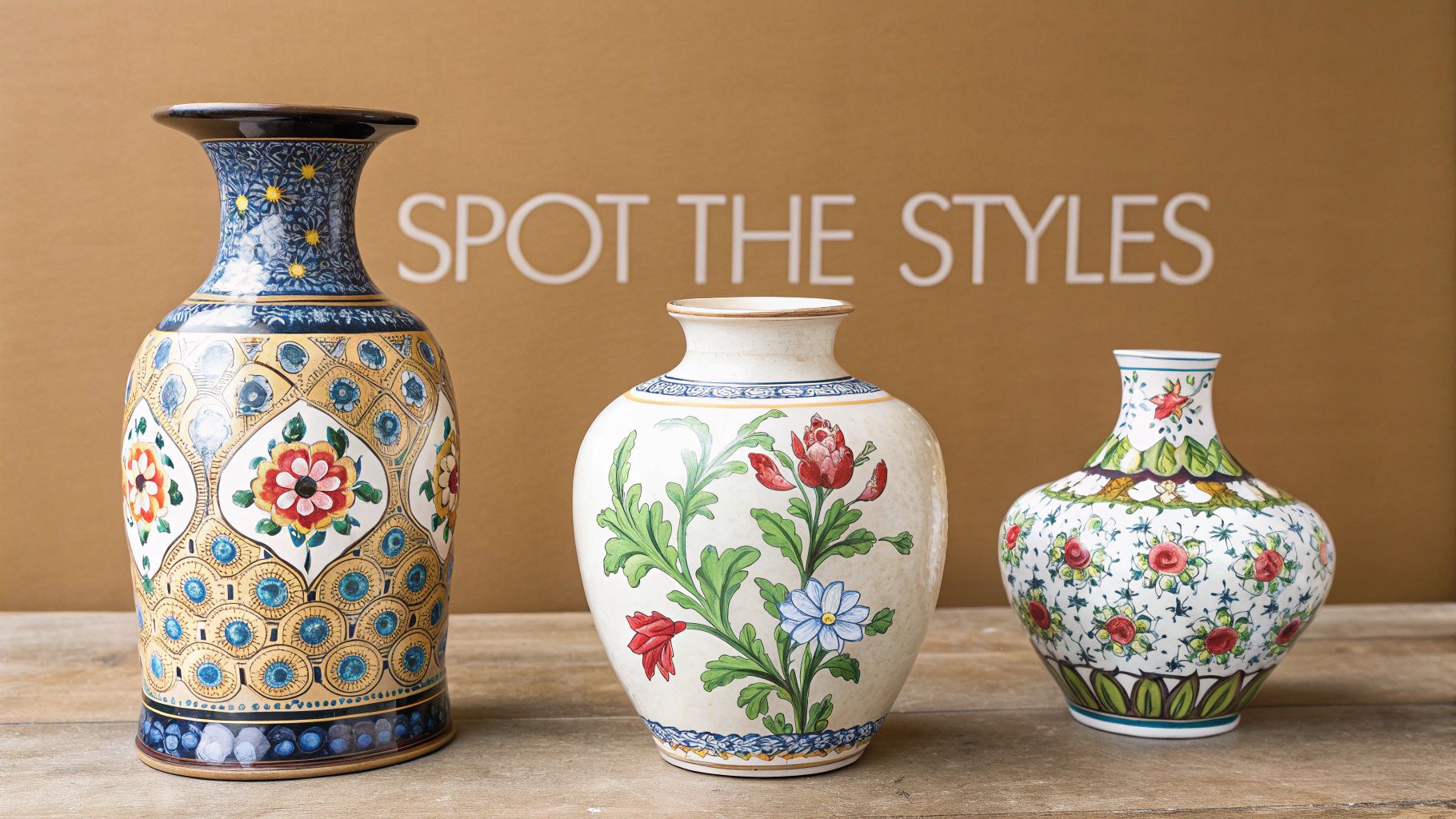
Learning to recognize the great traditions of Italian vase making is a lot like learning a new language. At first, all the shapes and colors might seem like a jumble, but you’ll soon start to pick out the distinct dialects of artistry. Each major style has its own signature, telling you a story about where it came from.
Think of this as your visual toolkit for moving beyond simply admiring antique vases from Italy to truly understanding them. By the end, you won't just see a beautiful object; you'll recognize the hands, the history, and the home behind its creation.
Let’s dive into the three titans of Italian craftsmanship.
Majolica: The Painted Storyteller
Imagine a vase that wears its heart on its sleeve, covered from top to bottom in bold, narrative scenes. That's the soul of Majolica, a special kind of tin-glazed earthenware that became the go-to canvas for Renaissance Italy. Its brilliant white surface was the perfect base for artists to paint directly onto, creating pieces that absolutely burst with life.
When you think you might be looking at Majolica, keep an eye out for these tell-tale signs:
- Vibrant, Hand-Painted Scenes: Look for mythological tales, historical events, or intricate portraits painted in rich blues, yellows, oranges, and greens.
- Earthenware Body: The vase itself is made from a relatively thick and porous pottery. This gives it a substantial, earthy feel compared to something delicate like porcelain.
- Regional Motifs: Famous centers like Deruta are known for their repeating geometric and floral patterns, while Faenza often features much more complex pictorial designs.
Think of Majolica as the illustrated manuscript of Italian ceramics. Each piece is designed to be "read," telling a story through its colorful and expressive artwork.
This style is all about bold expression and celebrating life, making it one of the most visually engaging forms of Italian pottery you’ll ever find.
Murano Glass: The Venetian Jewel
Now, let's head over to the Venetian island of Murano, where glassmaking was elevated into a legendary art form. Murano glass isn't so much about surface decoration as it is about the magic happening within the material itself. It’s a world of dazzling color, mind-bending patterns, and clarity like no other.
Identifying antique Murano glass means looking for the subtle signs of its handmade creation. Its value can be truly extraordinary, especially for pieces from renowned designers. In a stunning example from 2023, a 1940s Venini glass vase designed by Carlo Scarpa, originally bought at a thrift store for just $4, sold at auction for an astonishing $107,100. This really shows how rarity and a famous maker can create immense value.
When you’re examining a glass vase, keep an eye out for these Murano trademarks:
- Intense, Layered Colors: Murano is famous for rich, saturated colors that are part of the glass itself, not just painted on the surface.
- Innovative Techniques: Look for mesmerizing patterns like millefiori (a "thousand flowers" effect), swirling latticino (filigree glass), or the intentional inclusion of gold or silver flecks.
- Signs of the Hand: One of the best indicators is the pontil mark—a rough, unpolished spot on the base where the glassblower's rod was detached.
Capodimonte Porcelain: The Sculptural Masterpiece
Finally, we arrive in the delicate and romantic world of Capodimonte porcelain. This style was born from a royal desire to compete with the finest porcelain workshops in Europe, and in doing so, Capodimonte developed a look that is sculptural, ornate, and unmistakably elegant.
The defining feature of Capodimonte is its love for three-dimensional decoration. While Majolica tells stories on a flat surface, Capodimonte brings them to life with figures and flowers that seem to grow right out of the vase itself. Identifying these intricate pieces is a key step in figuring out if you have old vases worth money in your collection.
To spot a Capodimonte piece, you'll want to look for:
- Delicate, Hand-Applied Flowers: This is its most famous characteristic. Roses, lilies, and other blossoms are individually crafted and attached to the vase, creating a stunning, lifelike bouquet.
- Classical and Rococo Themes: Many pieces feature cherubs, mythological figures, and graceful scenes inspired by classical art.
- The Crowned 'N' Mark: Many authentic pieces bear a blue or gold mark of a crown over the letter 'N,' which signifies its Neapolitan origins.
To help you keep these styles straight, here's a quick cheat sheet that breaks down their key differences.
Identifying Key Italian Vase Styles
| Style | Primary Material | Key Characteristics | Famous Production Centers |
|---|---|---|---|
| Majolica | Tin-glazed Earthenware | Vibrant, hand-painted narrative scenes; brilliant white glaze; thick, earthy feel. | Deruta, Faenza, Urbino |
| Murano Glass | Glass | Intense, layered colors; techniques like millefiori and latticino; pontil mark on the base. | Venice (Island of Murano) |
| Capodimonte | Hard-paste Porcelain | Three-dimensional, hand-applied floral and figural decorations; delicate and ornate. | Naples |
This table can be a great starting point when you're out in the field. With a little practice, you'll soon be able to tell these Italian masters apart with just a quick glance.
How to Authenticate an Antique Italian Vase
Diving into the world of antique authentication can feel a bit like being a detective. It’s all about piecing together clues to figure out if what you're holding is the real deal. When it comes to antique vases from Italy, you're looking for the quiet whispers of history left by an artisan's hands, not the loud, perfect uniformity of a modern factory.
Think of an antique vase as a person with a story to tell. The base is its passport, stamped with marks that reveal where it's from. The weight and texture tell you about the materials it's made of, and the little signs of wear are the wrinkles that prove its age. Your job is to read that story by paying close attention to every detail.
Start with the Base
The bottom of a vase is often the most revealing spot. It's where makers traditionally left their mark, and it's a detail that forgers frequently get wrong. Flip the piece over carefully—always on a soft surface—and look for these key signs:
- Maker’s Marks and Signatures: Artisans from famous workshops like Capodimonte or smaller regional potteries often signed their work. These marks could be painted, stamped, or even scratched into the clay. Learning to spot these signatures is a key skill, and you can learn more about identifying specific vintage pottery marks in our detailed guide.
- The Pontil Mark: For hand-blown Murano glass, this is your number one clue. It’s a small, often rough, circular mark left where the glassblower’s pontil rod was snapped off after the piece was finished. A perfectly smooth, machine-finished base is a huge red flag for glass that claims to be antique.
Feel the Weight and Texture
Next, let your hands do some of the work. The materials used in genuine Italian antiques just feel different from mass-produced items.
True porcelain, like that from Capodimonte, is dense and feels surprisingly heavy for its size, with a cool, smooth surface. Earthenware, on the other hand, such as Majolica, will feel lighter and a bit more porous on any unglazed areas. If an item feels unnaturally light or has a chalky, almost plastic-like texture, you might be looking at a modern reproduction.
A genuine antique often has a certain "heft" to it. This substantial feel comes from the dense, high-quality clay and glass used by historic Italian workshops—a quality that modern fakes rarely bother to replicate.
Examine for Authentic Signs of Age
Real aging is almost impossible to fake well. A vase that has been around for a century or more will show honest, subtle signs of its journey through time.
Look for a fine network of tiny cracks in the glaze, a condition known as crazing. This happens naturally over many decades as the glaze and the ceramic body expand and contract at different rates. Also, check for gentle, honest wear on the base or rim where the vase would have rested on shelves and tables over the years. Be suspicious of any wear that looks too even or feels like it was applied intentionally.
The market for these pieces is serious business. While the global antique vase market is huge, Italian pieces—especially Capodimonte porcelain, Murano glass, and Renaissance majolica—hold a special place. For example, ornate Capodimonte porcelain vases can stand an impressive 20–25.5 inches tall. A pair in excellent condition can easily fetch tens of thousands of dollars. You can find more insights on valuing these exquisite pieces and see how condition impacts price over on Marks4Antiques.com. This just goes to show why taking the time to authenticate a piece is so critical to understanding its true worth.
Smart Strategies for Buying Your First Piece
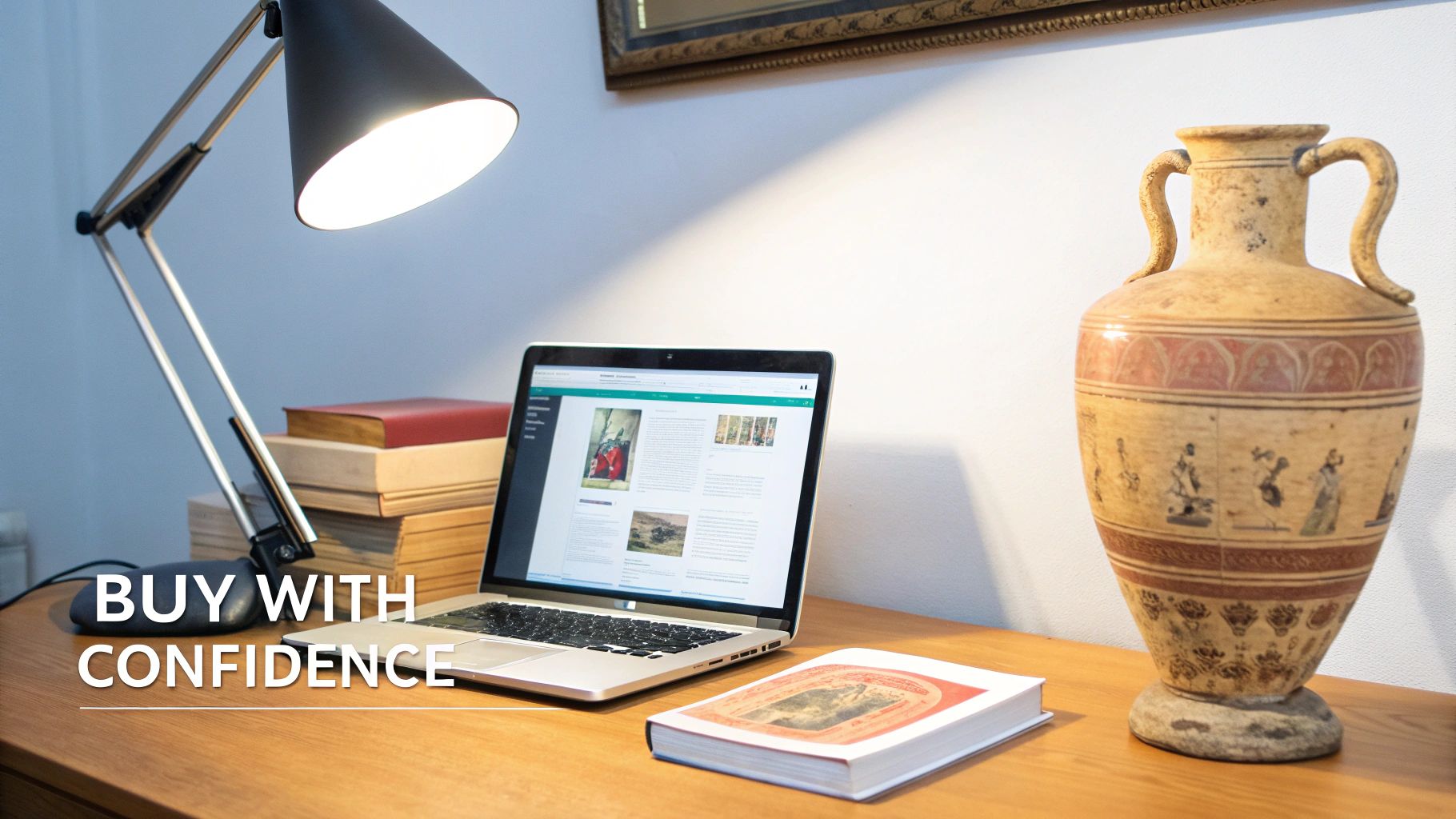
Alright, you've got the basics down for spotting and authenticating a piece. Now for the exciting part: actually buying one. Stepping into the market for the first time can feel a little overwhelming with all the dealers, auctions, and online shops. The secret is to go in with a clear plan and the right questions ready before you even consider pulling out your wallet.
Think of it like buying a vintage car. You wouldn't just buy it because the paint is shiny. You'd want to know its full history, pop the hood to check for repairs, and get a real sense of its condition. The same level of care applies to purchasing antique vases from Italy.
Choosing Your Buying Venue
Where you decide to buy is almost as important as what you buy. Every place offers a completely different vibe, with its own benefits and potential headaches. Knowing the difference helps you find the right fit for your budget and how comfortable you are with risk.
Here’s a quick rundown of the most common places to start your hunt:
- Reputable Antique Dealers: These are the pros. They have a carefully selected inventory and a reputation to uphold. You'll likely pay more, but you're also paying for their expertise, a guarantee of authenticity, and often a detailed backstory for the piece.
- Auction Houses: Auctions can be a real thrill and a great way to snag a rare find for a good price. But it's a fast-paced world. You have to do your homework ahead of time by carefully reading the auction catalog and any condition reports.
- Online Marketplaces: Sites like eBay or specialty antique portals give you access to a massive selection. You can definitely find some amazing deals, but the risk of stumbling upon a fake or a poorly described item is much higher. Stick to sellers who have a long history of positive feedback.
Decoding Condition Reports and Asking the Right Questions
When you find a vase that catches your eye, it’s time to channel your inner detective again. Don't ever hesitate to ask for more information. A good seller will be happy to answer your questions and be upfront about the piece.
Before you make a move, make sure you’re crystal clear on these key details:
- Provenance: Always ask about the vase's history. Where did it come from? Who were the previous owners? A paper trail, known as provenance, doesn't just add to the story—it can seriously boost a piece's value and help confirm it's the real deal.
- Condition Details: Learn the lingo. A "hairline crack" is a tiny fracture that hasn't split the ceramic, while "crazing" refers to that web of fine cracks you often see in old glaze—it's usually just a sign of age. Ask directly: "Are there any repairs, restorations, or chips I should know about?"
- Return Policy: This is a big one. Always, always confirm the return policy. It’s your safety net in case the vase shows up and isn't what was described.
A detailed condition report is your best friend. Look for honest descriptions of any flaws. A seller who openly points out a minor chip is often more trustworthy than one who claims a 150-year-old vase is "perfect."
Getting a feel for the market value is also a huge part of the process. To build your confidence, take some time to review well-researched price guides for antiques. This will give you the context you need to know what similar pieces are selling for, ensuring you make a smart offer and kick off your collection with a purchase you feel great about.
Common Questions About Collecting Italian Vases
As you start diving into the world of Italian antiques, you're bound to have questions. It’s completely normal! Think of this as a quick chat to clear up some of the most common head-scratchers, giving you the confidence to begin your own hunt.
Let's tackle a few of the questions I hear all the time from new collectors.
What Is the Difference Between Italian Pottery and Porcelain?
The real difference comes down to the clay and the heat. Think of Italian pottery, like Majolica, as being made from a more earthy, porous clay. It gets fired at lower temperatures and then coated in a thick, opaque glaze, which creates that perfect canvas for those vibrant, painted designs.
Porcelain, on the other hand, is a whole different beast. Pieces like Capodimonte are made from kaolin, a very fine white clay. They're fired at incredibly high temperatures until the clay becomes hard, non-porous, and almost translucent. That’s what gives porcelain its delicate, refined, and almost luminous quality.
How Can I Tell If a Murano Glass Vase Is Real?
Spotting authentic antique Murano glass is all about looking for the handmade tells. The biggest giveaway is usually the pontil mark on the bottom—a rough little spot where the glassblower’s rod was broken off after the piece was finished. It won't be perfectly smooth.
Because these were made by hand, not by a machine, you should also look for slight imperfections. Tiny air bubbles trapped inside the glass or a shape that isn’t perfectly symmetrical are good signs, not flaws.
An authentic Murano piece proudly displays the signs of its handmade origin. A perfectly symmetrical vase with no imperfections is often a red flag for modern, mass-produced glass.
While some pieces are signed by famous makers like Venini, many incredible antique examples are not. Always trust the physical evidence of the glass itself before you look for a signature.
Are All Antique Italian Vases Extremely Expensive?
Absolutely not! This is probably the biggest myth out there. While a museum-quality piece from a legendary designer will certainly have a hefty price tag, the market for antique vases from Italy is incredibly diverse.
You can find stunning antique and vintage pieces for just a few hundred dollars. Often, these are unsigned or come from smaller, lesser-known studios, but they are no less beautiful. A vase with a minor chip or some light crazing can also be a fantastic, affordable find. The goal is to find something you genuinely love—a piece of history that brings beauty into your home.
Of course, once you find your treasures, you'll want to protect them. If you ever need to move your collection, consulting an expert guide on how to pack fragile items for moving is a smart move.
Ready to uncover the story behind your own finds? With Curio, you can snap a photo to instantly identify antiques, get an estimated value, and learn their fascinating history. Turn your curiosity into expertise and start building your dream collection with confidence.
Download Curio today and let your antiques tell their story!
